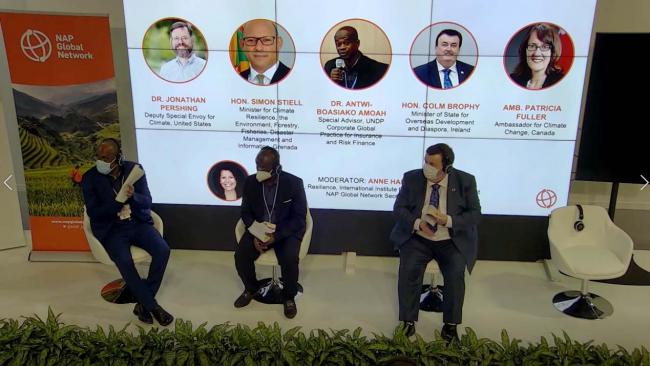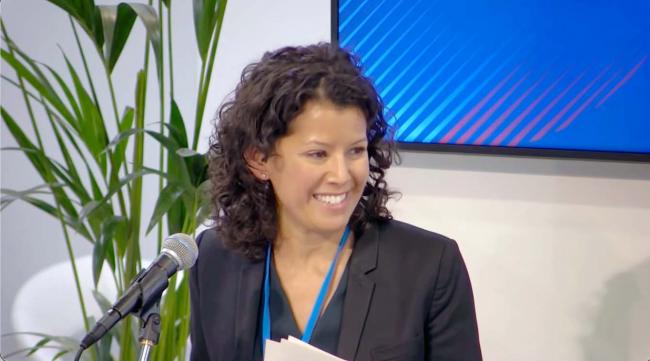Adaptation: From Planning to Action
Adaptation is vital to responding to climate change. But how can those countries most vulnerable to its impacts adapt quickly—especially as they work towards sustainable development? This event, organized by the National Adaptation Plan (NAP) Global Network, sought to share lessons learned by countries developing their NAPs for submission to the UNFCCC, as well as to announce new funding from donor countries to facilitate and build capacity for NAP planning and implementation.
The NAP Global Network, whose Secretariat is hosted by the International Institute for Sustainable Development: facilitates peer-to-peer knowledge exchange programmes and forums; supports national level action through its Country Support Hub; and develops resources and analyses that synthesize how countries are advancing their NAP processes. Founded in 2014, the Network now connects over 1,500 participants from 150 countries.
Moderator Anne Hammill, NAP Global Network Secretariat, introduced the event by noting that NAPs are long-term projects based in iterative learning. She highlighted the present need for NAPs to transition from planning to implementation, and praised financial support from Canada, Germany, the United States (US), Ireland, and the United Kingdom (UK). She said this allows for “strategic investments” so the NAP Global Network can: expand its technical support; innovate and experiment with peer learning; and make knowledge around NAP processes more accessible and compelling.
Jonathan Pershing, Deputy Special Envoy for Climate, US, echoed former US President Barack Obama’s call to reduce vulnerability and increase resilience across countries. He highlighted the President’s Emergency Plan for Adaptation and Resilience (PREPARE), which seeks to increase: knowledge-sharing; planning and programmes; and financing around the world. He concluded that “we do know how to build resilience,” but that doing so requires a collective effort, and that the NAP Global Network is essential to that goal.
Lessons Learned in Building NAPs
Trevor Thompson, Ministry of Agriculture and Lands, Grenada, shared lessons learned in designing a NAP for his country. He argued that monitoring and evaluation frameworks “should be number one” in planning for adaptation; noted the need to have climate change focal points in all sectors, including the private sector; and suggested NAPs should be kept “simple, implementable, and country-specific.” He also shared that, since Grenada adopted its NAP in 2017, actions had been taken in 75% of the measures outlined, with 36% of them completed.
Noting that NAPs must be “at the center of sustainability,” Antwi-Boasiako Amoah, Environmental Protection Agency, Ghana, shared Ghana’s vision for its NAP, including creating climate ambassadors in all sectors, among them the private sector. He stressed the need for political buy-in among policymakers, as well as for legal mechanisms that can ensure the plan is implemented and resources are correctly allocated. He concluded by saying district-level adaptation plans would also be necessary because “development happens at the local level.”
Siméon Sawadogo, Minister of Environment, Green Economy, and Climate Change, Burkina Faso, shared that the evaluation of Burkina Faso’s 2015 NAP showed that only 50% of objectives had been attained. He attributed this to a lack of financial resources and insufficient communication. He argued that needs for NAP development remain to be met, including capacity building for countries to identify and manage climate adaptation projects. He also called for setting up databases for disaggregated climate risks at the local level.
Ongoing and New Support for the Next Phase of NAPs
Colm Brophy, Minister of State for Overseas Development and Diaspora, Ireland, announced that Ireland will join the NAP Global Network as a donor, providing EUR 1 million to support small island developing states and least developed countries in strengthening transparency and accountability ahead of the 2023 Global Stocktake, with a special focus on monitoring and evaluation.
Patricia Fuller, Canadian Ambassador for Climate Change, highlighted that Canada has doubled its international climate finance commitment. She recalled that Canada recently announced a commitment of up to CAD 10 million to the NAP process, building on its initial investment of CAD 4 million, to focus on empowering women and girls, marginalized groups, and those most affected by climate impacts.
Philip Barton, Permanent Under-Secretary, Foreign, Commonwealth and Development Office, UK, explained that NAPs which integrate climate risks are a key mechanism in advancing climate adaptation. He highlighted the UK presidency’s priority of encouraging all countries to submit their adaptation communications to the UNFCCC, and to finalize and submit their NAPs to the UNFCCC. He concluded that NAPs are “the foundation for achieving adaptation at scale.”
In the subsequent discussions, participants spoke about, among others, the need for: monitoring and evaluation frameworks which extend into the private sector rather than only within the public sectors of countries; and a well-articulated communication plan to pass on valuable information to people at the community level.
Contact
Christian Ledwell | cledwell@iisd.ca
More information
NAP Global Network
Full Side Event Recording of "Adaptation: From Planning to Action"
To receive free coverage of global environmental events delivered to your inbox, subscribe to the ENB Update newsletter.






